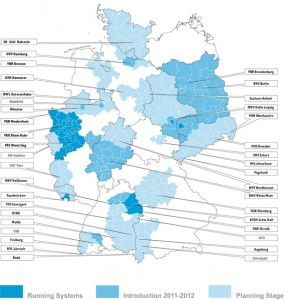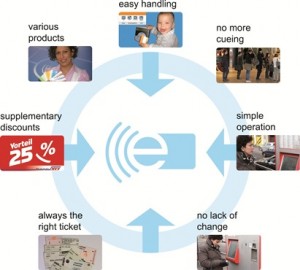(((eTicket Germany is ready for the future
- Like
- Digg
- Del
- Tumblr
- VKontakte
- Buffer
- Love This
- Odnoklassniki
- Meneame
- Blogger
- Amazon
- Yahoo Mail
- Gmail
- AOL
- Newsvine
- HackerNews
- Evernote
- MySpace
- Mail.ru
- Viadeo
- Line
- Comments
- Yummly
- SMS
- Viber
- Telegram
- Subscribe
- Skype
- Facebook Messenger
- Kakao
- LiveJournal
- Yammer
- Edgar
- Fintel
- Mix
- Instapaper
- Copy Link
Posted: 28 February 2013 | VDV-Kernapplikations GmbH & Co. KG | No comments yet
Public transport e-Ticketing in Germany started in the 19902 like in so many other nations. In those days, interested German public transport operators and authorities could not fall back on a nationwide standard for Electronic Fare Management (EFM). The result found about 35 different smartcard projects dotted all over Germany. Since then, there has been a dramatic change in passengers’ behaviour and requirements. Customers want to by their tickets quickly and simply and do not want to have to work their way through a complicated fare structure before they get the right ticket. So, in 2002, with funding from the German government, the Association of German Transport Companies (Verband Deutscher Verkehrsunternehmen (VDV)) started developing a standard for e-Ticketing in public transport.
Public transport e-Ticketing in Germany started in the 19902 like in so many other nations. In those days, interested German public transport operators and authorities could not fall back on a nationwide standard for Electronic Fare Management (EFM). The result found about 35 different smartcard projects dotted all over Germany. Since then, there has been a dramatic change in passengers’ behaviour and requirements. Customers want to by their tickets quickly and simply and do not want to have to work their way through a complicated fare structure before they get the right ticket. So, in 2002, with funding from the German government, the Association of German Transport Companies (Verband Deutscher Verkehrsunternehmen (VDV)) started developing a standard for e-Ticketing in public transport.
Public transport e-Ticketing in Germany started in the 19902 like in so many other nations. In those days, interested German public transport operators and authorities could not fall back on a nationwide standard for Electronic Fare Management (EFM). The result found about 35 different smartcard projects dotted all over Germany. Since then, there has been a dramatic change in passengers’ behaviour and requirements. Customers want to by their tickets quickly and simply and do not want to have to work their way through a complicated fare structure before they get the right ticket. So, in 2002, with funding from the German government, the Association of German Transport Companies (Verband Deutscher Verkehrsunternehmen (VDV)) started developing a standard for e-Ticketing in public transport.
From the beginning, the intention was to set a standard that could be integrated into other modes of transport (e.g. car-sharing or rent-a bike) and functions (e.g. access). This has proved to be the right move as, for example, young people who are no longer focused on owning their own car, now have the need and desire to use all types of transportation. The first version was released in 2005 by VDVKernapplikations GmbH & Co. KG (or VDV-KA KG), the company founded to develop and distribute the brand name: (((eTicket Deutschland (or (((eTicket Germany). Since then, VDV-KA KG has been further developed and this standard is fully operational today.
Central services available
Since the VDV-KA KG standard became available, the VDV-Kernapplikations GmbH & Co. KG turned from a developing company into a service company and is now offering, besides the core application itself, the necessary central systems to ensure interoperability. To make sure every participant of (((eTicket Germany is able to communicate with other participants, VDV-KA KG has built a central exchange service (ZVM), which supports the standard communication processes. The blocking list service (KOSES) generates and distributes blocking lists for all components of relevance to multiple organisations. This central exchange service has to be extremely flexible because of the different organisational structures in public transport in Germany: The counties are responsible for the local and regional transport and they have an independent position in organising their public transport.
To make participation as simple and efficient as possible for operators, VDV-KA KG developed the web-based application and security management (ASM) system. This guarantees availability of all important documents, such as specifications, and to simplify order-processes for security elements (e.g. SAMs). Last but not least, (((eTicket Germany components can be certificated on the basis of test reports from the Test Lab of CETECOM.
Growing numbers of participants
Since the first introduction of (((eTicket Germ – any in Saarbrücken in 2005, (((eTicket Germany has been growing and many regions became part of the (((eTicket Germany community. Within the first three years of its existence, seven pilot regions started e-Ticketing in Germany – aside from Saarbahn, these were: Kreisverkehr Schwäbisch Hall; Nahverkehr Hohenlohekreis; Ostalb mobil; Verkehrsverbund Rhein-Ruhr (VRR); Verkehrsgemeinschaft Niederrhein (which joined the VRR in January 2012); and Verkehrsverbund Rhein-Sieg (VRS). In 2010, these public transport authorities generated a one billion Euro per year turn-over with (((eTicket Germany – a remarkable 10% of the total turnover of regional and local public transport in Germany. By the end of 2012, eight million smartcards had been ordered by public transport organisations and most of them are issued to customers all over Germany.
In mid-2012, VDV-KA KG issued a tender for smartcards in the name of 70 PTOs and PTAs. The result was a price reduction of about 50% which lead to heavy savings for all (((eTicket Germany participants.
More flagship-projects
In 2012, an important year for (((eTicket Germany, three big players joined the map: Berlin-Brandenburg (VBB), Hamburg (HVV) and the Rhein-Main-Area including Frankfurt (RMV). Starting their projects in 2011, these flagship-projects began their roll-out of (((eTicket in 2012.
And this is not the end. Münster, Bielefeld, Nürnberg, Stuttgart, Hannover and some other regions will soon follow. The projects in Münster and Stuttgart are particularly exciting – both regions will connect public transfer with other functionalities, like car-sharing, rent-a-bike or parking. On top of this, customers will use their smartcard to gain entrance to public libraries, museums, public swimming pools and even to a cinema (Münster).
(((eTicket Germany abroad
(((eTicket Germany ensures the interoperability of EFM for Germany. In addition, the aim is to establish interoperable EFM at European level.
Within the scope of an initial EU programme, VDV-KA KG has joined forces with the Calypso Network Association of Belgium and ITSO Limited of the United Kingdom to develop a plan for the creation of interoperability for fare management in Europe.
The first step is the application download of the respective EFM application to the local medium. Anticipating the end of this development, VDV-KA KG, Calypso and ITSO were able to present a smartcard on which not only the VDV Core Application, but also the British ITSO and Calypso were loaded.
Memorandum of Understanding
At IT-Trans 2012 in Karlsruhe, VDV-KA KG, ITSO, Calypso Network, the AFIMB (French Agency for Multimodal Information and Ticketing) and the UITP (International Association of Public Transport) signed a Memorandum of Under standing (MoU) which provides the basis for a collaborative venture between the signatories in the context of presentday infrastructures and systems and is also available to other stakeholders – the aim being to create a European alliance for the development of European interoperability. The key messages of the memorandum are that the signatories:
● Support the further development of the inter operability of European e-Ticketing systems
● Agree to the formation of a collaborative platform
● Support the organisation of the IFM Alliance at European level
● Seek close collaboration between the European institutions and financial assistance for an EU project as proposed in the MoU
● Invite further European stakeholders at national level to support and participate in the future development of European interoperability.
Luxemburg: one smartcard – two applications
The principality of Luxemburg recently finished a tender for chip-cards based on the VDV core application as well as the French ‘Calypso’. As a small country with strong connections and many cross-border commuters, the Luxemburg public transport authorities have a strong wish for an interoperable system for both French/ Belgian and German customers. Luxemburg is planning to introduce their new system in 2013/2014. This would be the first time customers could travel cross border with just one electronic media.
Upgrading structure of VDV-KA KG
The steady growth of (((eTicket Germany has made it necessary to internally reorganise the VDV-KA KG. A set of bodies was set up in 2012 with the introduction the Board of Commissioners and the Participants Assembly, which come together once or twice a year.
There is a set of decision bodies and a consulting set. The decision body includes the User Board (Implementation), the Share – holder Board (Property of VDV-KA KG), the VDV-KA Management Company (Owner of the KA-Specifications) and the Board of Comm – issioners (Strategy).
The Consulting Body consists of experts, who work on special subjects in Working Groups, the Politics and Science Consulting Committee and the PT Sector Consulting Committee.
Next steps
Another great challenge in 2013 will be the development and introduction of a VDV smart – phone app which should connect existing, and probably new, mobile ticketing systems to make interregional distribution of regional tickets possible. To achieve this, VDV-KA KG will develop the necessary interfaces (IPSI). The medium-term goal is to sell 5-7% of all single/multiple tickets by mobile-ticketing within the next 3-5 years.
In 2013, VDV-KA KG will celebrate its 10th anniversary. Many things have changed since its inception. Originally founded just for developing the German e-Ticket standard, the company has progressed and has (((eTicket Germany as a whole. By introducing a new communication platform (Homepage, SharePoint, ASM), building central systems (ZVM, KOSES, Test-Lab) and upgrading the organisa – tional structure, (((eTicket Germany is ready for the future.
Biographies
Sjef Janssen is Managing Director of VDV-Kernapplikations GmbH & Co. KG. Previously, Sjef was a management member of a large Dutch transport comp – any and also worked for the Dutch association of public transport in chip-card development.
Daniel Krings is responsible for Marketing & Communication at VDV-Kernapplikations GmbH & Co. KG. Previously, Daniel worked as a radio journalist for a private German radiobroadcaster and managed several ticket-shops (entertainment) in the south-west of Germany.










